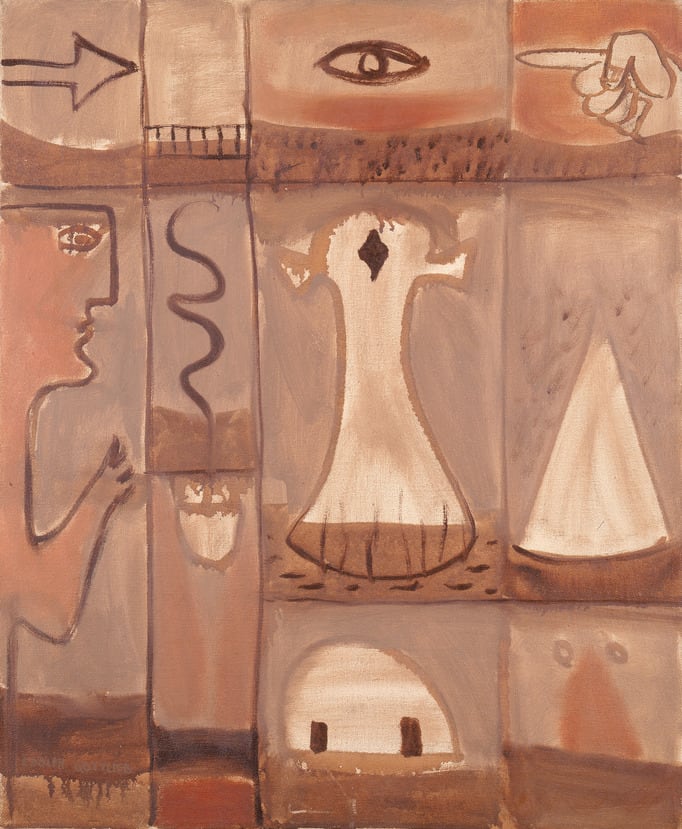
- Artist/Maker:
- Adolph Gottlieb
- Bio:
- b. 1903, New York, New York; d. 1974, New York, New York
- Title:
- Return of the Mariner
- Portfolio/Series:
- Pictographs
- Date:
- 1946
- Medium:
- Oil on canvas
- Dimensions:
- 24 × 20 in. (61 × 50.8 cm)
- Credit Line:
- Gift of an anonymous donor
- Accession Number:
- 2005-24
- Copyright:
- Art © Adolph and Esther Gottlieb Foundation/Licensed by _VAGA_, New York, NY
Not On View
In 1943 Adolph Gottlieb and Mark Rothko became the first artists to articulate the tenets of the movement that would become known as Abstract Expressionism. In a letter to the New York Times, they wrote: "There is no such thing as good painting about nothing. We assert that the subject is crucial and only that subject matter is valid which is tragic and timeless. This is why we profess spiritual kinship with primitive and archaic art." Gottlieb was at the center of this diverse group of artists that included Jackson Pollock, Willem de Kooning, Barnett Newman, and Mark Rothko. Along with writers and musicians, these Abstract Expressionist painters and sculptors transformed New York into the new intellectual and artistic center, replacing Paris as the avant-garde mecca. These artists were aware of the European modernists because of their recent arrival to New York, in exile during World War II. However, seeking independent identities, the Abstract Expressionists strove to create a distinctly American idiom. Fourteen years after their declaration of artistic ideals, The Jewish Museum mounted a solo exhibition of Adolph Gottlieb's work. This inaugurated the focus on avant-garde art that became seminal to The Jewish Museum's mission during the 1960s and provided New York with its first major museum exhibition of the work of an Abstract Expressionist artist.
Return of the Mariner is an example of Gottlieb's aesthetic and conceptual innovation that he called the "pictograph." He began by dividing his canvases into a grid, which was a process that refers not only to Mondrian's rational modernist compositions, but to the partitioned panels of Renaissance narrative altarpieces. He then used free association, a Freudian method formerly used by the Surrealists, to fill the compartments with symbols. He invented these from a lexicon of premodern, tribal, and mythological sources that he had seen during his travels. Through his concentration on Carl Jung's theories of archetypes and the collective unconscious, Gottlieb began to understand how to synthesize these various sources. His paintings were also, for the artist, vehicles for addressing the brutality and destruction of World War II.
Gottlieb was one of the more reserved and intellectuals of the Abstract Expressionists, spending time at his home in Brooklyn Heights instead of in the raucous Cedar Tavern in Manhattan, where his cohorts gathered regularly. For most of his life, he kept a small boat at a dock in Brooklyn and sometimes raced regattas in New England. The title Return of the Mariner refers to the voyages of Theseus and Odysseus, as well as to Gottlieb's own recollections of his time on the sea. The artist's conflation of the heroic and intimate, the powerful and serene, accounts for some of the mysterious force that imbues his paintings with a transcendent aura.
Return of the Mariner is an example of Gottlieb's aesthetic and conceptual innovation that he called the "pictograph." He began by dividing his canvases into a grid, which was a process that refers not only to Mondrian's rational modernist compositions, but to the partitioned panels of Renaissance narrative altarpieces. He then used free association, a Freudian method formerly used by the Surrealists, to fill the compartments with symbols. He invented these from a lexicon of premodern, tribal, and mythological sources that he had seen during his travels. Through his concentration on Carl Jung's theories of archetypes and the collective unconscious, Gottlieb began to understand how to synthesize these various sources. His paintings were also, for the artist, vehicles for addressing the brutality and destruction of World War II.
Gottlieb was one of the more reserved and intellectuals of the Abstract Expressionists, spending time at his home in Brooklyn Heights instead of in the raucous Cedar Tavern in Manhattan, where his cohorts gathered regularly. For most of his life, he kept a small boat at a dock in Brooklyn and sometimes raced regattas in New England. The title Return of the Mariner refers to the voyages of Theseus and Odysseus, as well as to Gottlieb's own recollections of his time on the sea. The artist's conflation of the heroic and intimate, the powerful and serene, accounts for some of the mysterious force that imbues his paintings with a transcendent aura.
Information may change as a result of ongoing research.